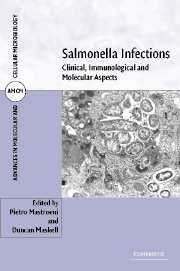Book contents
- Frontmatter
- Contents
- List of contributors
- Preface
- 1 Epidemiological and clinical aspects of human typhoid fever
- 2 Antibiotic resistance in Salmonella infections
- 3 Host-specificity of Salmonella infections in animal species
- 4 Public health aspects of Salmonella enterica in food production
- 5 The Salmonella genome: a global view
- 6 Pathogenicity islands and virulence of Salmonella enterica
- 7 In vivo identification, expression and function of Salmonella virulence genes
- 8 Mechanisms of immunity to Salmonella infections
- 9 Interactions of S. enterica with phagocytic cells
- 10 Interactions between Salmonella and dendritic cells: what happens along the way?
- 11 Immunity to Salmonella in domestic (food animal) species
- 12 Newer vaccines against typhoid fever and gastrointestinal salmonelloses
- 13 S. enterica-based antigen delivery systems
- Index
- Plate section
- References
6 - Pathogenicity islands and virulence of Salmonella enterica
Published online by Cambridge University Press: 04 December 2009
- Frontmatter
- Contents
- List of contributors
- Preface
- 1 Epidemiological and clinical aspects of human typhoid fever
- 2 Antibiotic resistance in Salmonella infections
- 3 Host-specificity of Salmonella infections in animal species
- 4 Public health aspects of Salmonella enterica in food production
- 5 The Salmonella genome: a global view
- 6 Pathogenicity islands and virulence of Salmonella enterica
- 7 In vivo identification, expression and function of Salmonella virulence genes
- 8 Mechanisms of immunity to Salmonella infections
- 9 Interactions of S. enterica with phagocytic cells
- 10 Interactions between Salmonella and dendritic cells: what happens along the way?
- 11 Immunity to Salmonella in domestic (food animal) species
- 12 Newer vaccines against typhoid fever and gastrointestinal salmonelloses
- 13 S. enterica-based antigen delivery systems
- Index
- Plate section
- References
Summary
INTRODUCTION
Horizontal gene transfer and bacterial virulence
Bacteria show a remarkable ability to adapt rapidly to new habitats. This observation also applies to pathogenic bacteria that have evolved strategies to colonize various anatomical niches of their multi-cellular hosts. The acquisition of genetic material by a process termed horizontal gene transfer is considered to be a driving force for the rapid evolution of bacteria as pathogens. Extrachromosomal DNA such as plasmids conferring resistance to antibiotics were the first horizontally transferred DNA elements to be identified, but later it became obvious that there are also mechanisms that allow the horizontal transfer of chromosomal DNA elements. The observation that certain virulence functions are clustered in distinct regions of the chromosome and that these regions are genetically unstable and were deleted with high frequencies gave the first clue about the existence of the new form of genetic elements. The term ‘Pathogenicity Island’ (PAI) was first introduced in 1983 by Hacker and colleagues who observed genetic instability of genes associated with the haemolytic activity of uropathogenic strains of Escherichia coli (Hacker et al., 1983). PAI were initially defined as large, unstable regions of the chromosome. With the identification of a large number of additional PAIs in various groups of bacterial pathogens, further common features were found.
Definition of pathogenicity islands
The following common characteristics were defined for PAIs:
They are large, distinct genetic entities on the bacterial chromosome.
They harbor one or more virulence genes.
They are often genetically unstable. This feature correlates with the presence of genetic elements involved in DNA-mobility, such as direct repeats, integrases, transposases and bacteriophage genes.
[…]
- Type
- Chapter
- Information
- Salmonella InfectionsClinical, Immunological and Molecular Aspects, pp. 146 - 172Publisher: Cambridge University PressPrint publication year: 2006



